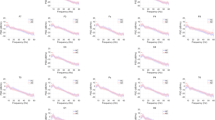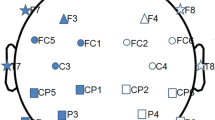Abstract
To the best knowledge of the authors there is no study on nonlinear brain dynamics of down syndrome (DS) patients, whereas brain is a highly complex and nonlinear system. In this study, fractal dimension of EEG, as a key characteristic of brain dynamics, showing irregularity and complexity of brain dynamics, was used for evaluation of the dynamical changes in the DS brain. The results showed higher fractality of the DS brain in almost all regions compared to the normal brain, which indicates less centrality and higher irregular or random functioning of the DS brain regions. Also, laterality analysis of the frontal lobe showed that the normal brain had a right frontal laterality of complexity whereas the DS brain had an inverse pattern (left frontal laterality). Furthermore, the high accuracy of 95.8 % obtained by enhanced probabilistic neural network classifier showed the potential of nonlinear dynamic analysis of the brain for diagnosis of DS patients. Moreover, the results showed that the higher EEG fractality in DS is associated with the higher fractality in the low frequencies (delta and theta), in broad regions of the brain, and the high frequencies (beta and gamma), majorly in the frontal regions.





Similar content being viewed by others
References
Adeli H, Ghosh-Dastidar S, Dadmehr N (2007) A wavelet-chaos methodology for analysis of EEGs and EEG subbands to detect seizure and epilepsy. IEEE Trans Biomed Eng 54(2):205–211
Ahmadlou M, Adeli H (2010a) Wavelet-synchronization methodology: a new approach for EEG-based diagnosis of ADHD. Clin EEG Neurosci 41(1):1–10
Ahmadlou M, Adeli H (2010b) Enhanced probabilistic neural network with local decision circles: a robust classifier. Integr Comput Aided Eng 17(3):197–210
Ahmadlou M, Adeli H (2011a) Functional community analysis of brain: a new approach for EEG-based investigation of the brain pathology. Neuroimage 58(2):401–408
Ahmadlou M, Adeli H (2011b) Fuzzy synchronization likelihood with application to attention deficit hyperactivity disorder. Clin EEG Neurosci 42(1):6–13
Ahmadlou M, Adeli H (2012) Visibility graph similarity: a new measure of generalized synchronization in coupled dynamic systems. Physica D 241(4):326–332
Ahmadlou M, Adeli H, Adeli A (2010a) Fractality and a wavelet-chaos-neural network methodology for automated EEG-based diagnosis of autistic spectrum disorder. J Clin Neurophysiol 27(5):328–333
Ahmadlou M, Adeli H, Adeli A (2010b) New diagnostic EEG markers of the Alzheimer’s disease using visibility graphs. J Neural Transm 117(9):1099–1109
Ahmadlou M, Adeli H, Adeli A (2011) Fractality and a wavelet-chaos methodology for EEG-based diagnosis of Alzheimer’s disease. Alzheimer Dis Assoc Disord 25(1):85–92
Ahmadlou M, Adeli H, Adeli A (2012a) Graph theoretical analysis of organization of functional brain networks in ADHD. Clin EEG Neurosci 43(1):5–13
Ahmadlou M, Adeli H, Adeli A (2012b) Improved visibility graph fractality with application for the diagnosis of autism spectrum disorder. Phys A 391(20):4720–4726
Ahmadlou M, Adeli H, Adeli A (2012c) Fractality analysis of frontal brain in major depressive disorder. Int J Psychophysiol 85(2):206–211
Ahmadlou M, Adeli H, Adeli A (2012d) Fuzzy synchronization likelihood-wavelet methodology for diagnosis of autism spectrum disorder. J Neurosci Methods 211(2):203–209
Ahmadlou M, Rostami R, Sadeghi V (2012e) Which attention-deficit/hyperactivity disorder children will be improved through neurofeedback therapy? A graph theoretical approach to neocortex neuronal network of ADHD. Neurosci Lett 516(1):156–160
Ahmadlou M, Ahmadi K, Rezazade M, Azad-Marzabadi E (2013) Global organization of functional connectivity brain networks in methamphetamine abusers. Clin Neurophysiol (in press).
Babiloni C, Albertini G, Onorati P, Vecchio F, Buffo P, Sarà M, Condoluci C, Pistoia F, Carducci F, Rossini PM (2009) Inter-hemispheric functional coupling of eyes-closed resting EEG rhythms in adolescents with down syndrome. Clin Neurophysiol 120(9):1619–1627
Catarino A, Churches O, Baron-Cohen S, Andrade A, Ring H (2011) Atypical EEG complexity in autism spectrum conditions: a multiscale entropy analysis. Clin Neurophysiol 122(12):2375–2383
Danés CF (2012) Specific aspects of ageing in down’s syndrome. Rev Med Int Sindr Down 16(1):3–10
Esteller R, Vachtsevanos G, Echauz J, Litt B (2001) A comparison of waveform fractal dimension algorithms. IEEE Trans Circuit Syst 48(2):177–183
Fernández A, Quintero J, Hornero R, Zuluaga P, Navas M, Gómez C, Escudero J, García-Campos N, Biederman J, Ortiz T (2009) Complexity analysis of spontaneous brain activity in attention-deficit/hyperactivity disorder: diagnostic implications. Biol Psychiatry 65(7):571–577
Ferrer I, Gullotta F (1990) Down’s syndrome and Alzheimer’s disease: dendritic spine counts in the hippocampus. Acta Neuropathol 79(6):680–685
Gao J, Hu J, Tung WW (2011) Complexity measures of brain wave dynamics. Cogn Neurodyn 5(2):171–182
Higuchi T (1988) Approach to an irregular time series on the basis of the fractal theory. Phys D 31(2):277–283
Hu M, Liang H (2011) Intrinsic mode entropy based on multivariate empirical mode decomposition and its application to neural data analysis. Cogn Neurodyn 5(3):277–284
Katz M (1988) Fractals and the analysis of waveforms. Comput Biol Med 18(3):145–156
Kaufmann WE, Moser HW (2000) Dendritic anomalies in disorders associated with mental retardation. Cereb Cortex 10(10):981–991
Kiebel SJ, Garrido MI, Moran RJ, Friston KJ (2008) Dynamic causal modeling for EEG and MEG. Cogn Neurodyn 2(2):121–136
Klimesch W, Arora A (2012) The EEG frequency architecture, coupled oscillations and consciousness: comment on ‘consciousness, biology and quantum hypotheses’ by Baars and Edelman. Phys Life Rev 9(3):295–296
Nadel L (2003) Down’s syndrome: a genetic disorder in biobehavioral perspective. Genes Brain Behav 2(3):156–166
Nakatani H, Orlandi N, van Leeuwen C (2011) Precisely timed oculomotor and parietal EEG activity in perceptual switching. Cogn Neurodyn 5(4):399–409
Ozaki TJ, Sato N, Kitajo K, Someya Y, Anami K, Mizuhara H, Ogawa S, Yamaguchi Y (2012) Traveling EEG slow oscillation along the dorsal attention network initiates spontaneous perceptual switching. Cogn Neurodyn 6(2):185–198
Pinter JD, Eliez S, Schmitt JE, Capone GT, Reiss AL (2001) Neuroanatomy of down’s syndrome: a high-resolution MRI study. Am J Psychiatry 158(10):1659–1665
Sannita WG, Di Bon G, Rosadini G, Shmeuli R (1993) Correlation of quantitative EEG with age in down’s syndrome. Electroencephalogr Clin Neurophysiol 87(2):S51
Schinkel S, Marwan N, Kurths J (2007) Order patterns recurrence plots in the analysis of ERP data. Cogn Neurodyn 1(4):317–325
Schmid RG, Tirsch WS, Rappelsberger P, Weinmann H-M, Pöppl SJ (1992) Comparative coherence studies in healthy volunteers and down’s syndrome patients from childhood to adult age. Electroencephalogr Clin Neurophysiol 83(2):112–123
Sohn H, Kim I, Lee W, Peterson BS, Hong H, Chae J-H, Hong S, Jeong J (2010) Linear and non-linear EEG analysis of adolescents with attention-deficit/hyperactivity disorder during a cognitive task. Clin Neurophysiol 121(11):1863–1870
Vialatte FB, Dauwels J, Maurice M, Yamaguchi Y, Cichocki A (2009) On the synchrony of steady state visual evoked potentials and oscillatory burst events. Cogn Neurodyn 3(3):251–261
Wang C, Zou J, Zhang J, Wang M, Wang R (2010) Feature extraction and recognition of epileptiform activity in EEG by combining PCA with ApEn. Cogn Neurodyn 4(3):233–240
Acknowledgments
Many thanks go to the reviewers for their effective comments and helpful advices in the revision procedure.
Author information
Authors and Affiliations
Corresponding author
Additional information
Sahel Hemmati and Mehran Ahmadlou had equal contribution in this research and both should be considered as the first author.
Rights and permissions
About this article
Cite this article
Hemmati, S., Ahmadlou, M., Gharib, M. et al. Down syndrome’s brain dynamics: analysis of fractality in resting state. Cogn Neurodyn 7, 333–340 (2013). https://doi.org/10.1007/s11571-013-9248-y
Received:
Revised:
Accepted:
Published:
Issue Date:
DOI: https://doi.org/10.1007/s11571-013-9248-y




